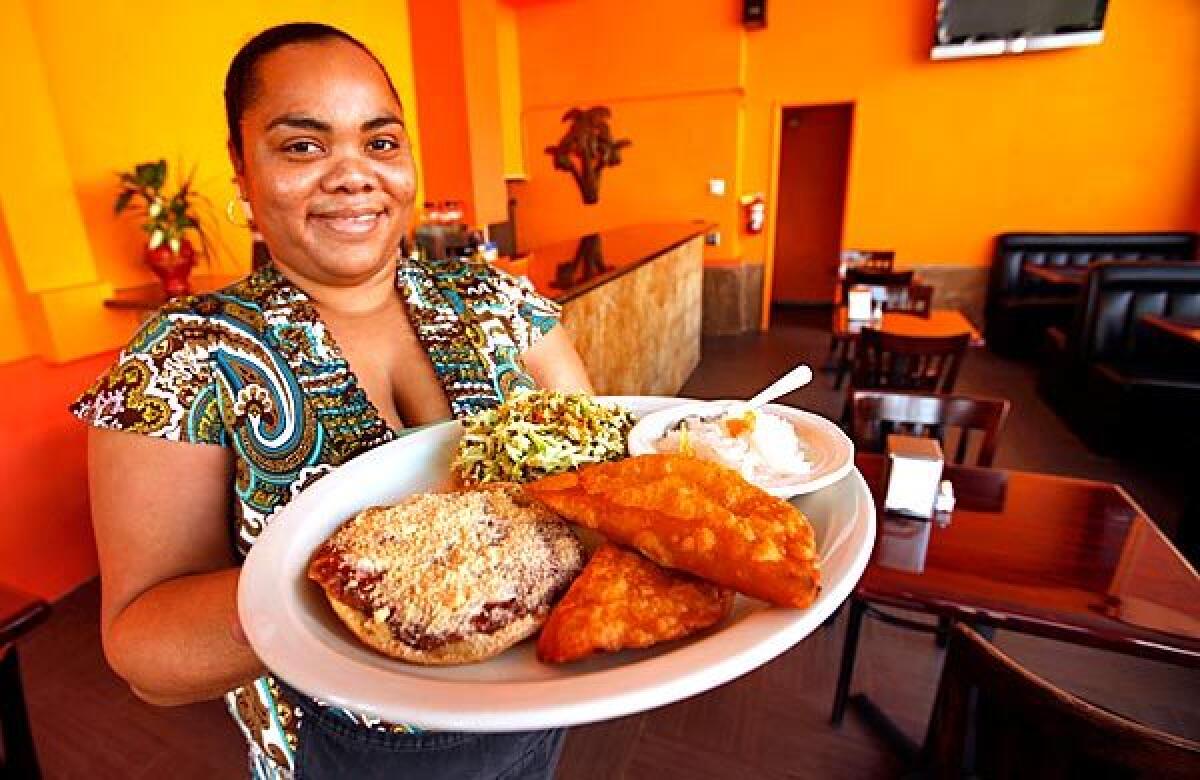The Find: Flavors of Belize

- Share via
Chirmole, a high-intensity soupy sauce as black as squid ink, is poured over tender poached chicken and holds a single hard-cooked egg. This classic Maya dish, dubbed “black dinner” in tiny Central American Belize, is based on darkly charred chiles, ground to a mud-colored paste with a litany of seasonings as complex as that of any Oaxacan mole. It’s easy to go through several baskets of corn tortillas mopping up every trace of its toasty, hauntingly pungent liquid.
Chirmole is a weekend indulgence at Flavors of Belize, one of the first new restaurants to offer this cuisine in a very long time. The freshly minted cafe, on La Brea Avenue near San Vicente Boulevard, occupies the former coffee shop of the Relax Inn, an aging motel whose ‘50s-era exterior color scheme of bright coral and turquoise contrasts with the small dining room’s sophisticated buff-and-tan hues in an only-in-L.A. sort of way.
After nearly a year and a half revamping the place, its owners, the Pariente family (who did the work themselves), unveiled a diminutive but polished restaurant with a new kitchen, comfy upholstered booths and faux stone wainscoting etched with Maya motifs. The only touch of hominess in a sea of surrounding fast-food outlets, it would be easy to miss but for its bright yellow banner announcing “Now Open.”
Matriarch Zelda Pariente heads the kitchen with daughter Edna Guevara as sous-chef.
“Back home, Mom was famous for her Belizean-style tamales — at one point she supported the family making and selling them,” says daughter Diamine Pariente, who looks after the front of the house on weekends with her brother Oscar.
On each mahogany-hued table a jar of bright orange house-made hot sauce glows like a beacon. It’s a distillation of the habanero chiles so emblematic of Belizean food. The palate-scorching pods, essential in the Yucatecan kitchen, originated in the Caribbean. Both regions play major roles in Belize’s cuisine as does a culinary legacy from Africa.
Every feast at Flavors of Belize begins with a basket of thick, hand-cut freshly fried chips and a bowl of chile-tinged bean dip. Try to restrain yourself because you’ll want to try the salbutes before your entrée. An obvious cousin of the tostada, they’re based on fragile house-made fried tortillas holding a hillock of shredded chicken topped off with crunchy shredded cabbage drizzled with sweet-tart sauce.
You could put together a satisfying small plates-style meal from the list of appetizers (you’d miss the chirmole, though). But know that the panades feature hand-rolled corn dough folded around well-seasoned minced fish or beans, and the conch fritters may be the tastiest snail dish you’ve ever had.
Although the weekday menu is a little more limited in the entrée department, there are always ducunu, and they’re worth a trek across town. The unfilled tamales, composed of fresh corn grated off the cob, then ground and formed into sweet-savory logs, taste wonderful on their own and spectacular with stewed pork, beef or chicken.
Coconut milk — the Caribbean influence — injects a velvety richness to the stewed beef and pork; they soak up the seasoned milk like a Thai or Indonesian rendang curry. Coconut milk also lends its richness to rice dishes. It’s widely joked that if you get tired of beans and rice in Belize, you can always have rice and beans. Any Belizean will tell you the two are entirely different.
Whereas rice and beans are cooked together with coconut milk, coconut milk-cooked beans and rice come side-by-side. Unlike the black bean versions from Cuba, red pinto beans with a lush creamy texture star here. Either dish accompanies long-simmered beef or pork, fall-off-the-bone oxtail or chicken bathed in umami-laden brown sauce.
Pork part addicts won’t want to miss the legendary African-inspired boil-up, another weekend special. Based on braised cured pig tail with a juicy fat layer surrounding the meat, it accompanies a huge platter of saucy “ground vegetables,” an African slang term for starchy cassava (yuca), taro known as coco, potato and green plantains. The whole, under a blanket of onion-rich tomato sauce, is served up with boilcake — a pot-cooked flour dumpling. It’s not a creation for the culinarily timid.
More weekend specials include coconut-enriched conch soup made with the mollusk’s meat pounded to a forgiving tenderness. Thickened with “Matilda foot,” slang for ground green plantain, it’s served with coconut milk-infused rice.
So far desserts are limited to yellow cake cut into squares and spread with a rich caramel icing. More will soon follow, says the family. But even now you can get a Belize-style weekend breakfast with over-easy eggs and puffy fry jack (fried dough), a succulent white meat chicken-filled tamal with the texture of a delicate savory pudding and a refreshing cold drink of pureed guanabana fruit called soursop juice.
LOCATION: 1271 S. La Brea Ave., Los Angeles; (323) 931-4840
PRICES: Appetizers, $1 to $3; entrees, $2.25 to $15.99
DETAILS: Open 11 a.m. to 8 p.m. Tuesday to Thursday, 11 a.m. to 9 p.m. Friday, and 8 a.m. to 9 p.m. Saturday. No alcohol, credit cards accepted, lot and street parking. Delivery available.
More to Read
Eat your way across L.A.
Get our weekly Tasting Notes newsletter for reviews, news and more.
You may occasionally receive promotional content from the Los Angeles Times.










